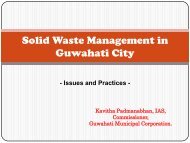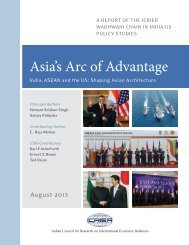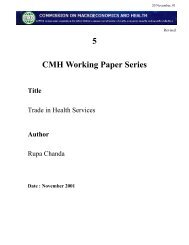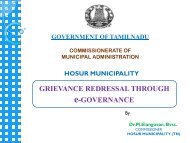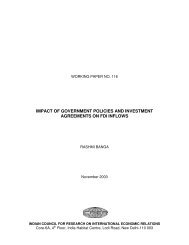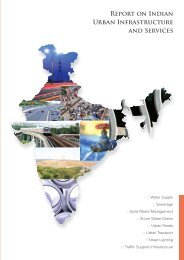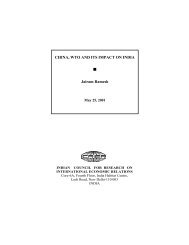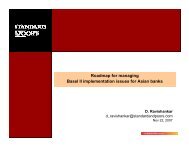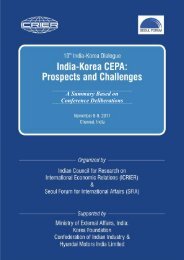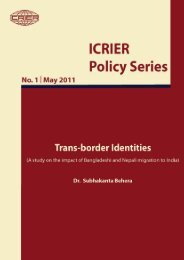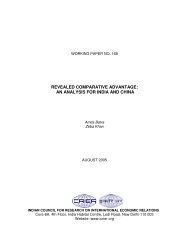Export Processing zones in India
Export Processing zones in India
Export Processing zones in India
You also want an ePaper? Increase the reach of your titles
YUMPU automatically turns print PDFs into web optimized ePapers that Google loves.
Foreword<br />
Malaysia and other ASEAN countries were among the first to successfully use <strong>Export</strong><br />
<strong>Process<strong>in</strong>g</strong> Zones (EPZs) to <strong>in</strong>crease exports and thus reduce the foreign exchange constra<strong>in</strong>ts<br />
aris<strong>in</strong>g from import substitut<strong>in</strong>g <strong>in</strong>dustrial risk. More importantly, these <strong>zones</strong> were used as a<br />
‘test base’ for liberalisation of trade, tax and other policies that were then gradually applied to<br />
the rest of the economy. More recently, Ch<strong>in</strong>a has been the most successful practitioner of this<br />
<strong>in</strong>strument, and has taken it to new height what might be called the “FDI-Expert model” of<br />
economic development and growth. Experience suggests that the geographically def<strong>in</strong>ed and<br />
restricted <strong>zones</strong> are suitable for “<strong>Export</strong> <strong>Process<strong>in</strong>g</strong>” as their name (EPZ) implies. That is<br />
carry<strong>in</strong>g out those stages of production that have high import content and perhaps require<br />
relatively greater unskilled labour. The fact that electronics exports have been the most<br />
successful exports from <strong>India</strong>n EPZs supports this conclusion. The collapse of eng<strong>in</strong>eer<strong>in</strong>g<br />
exports from <strong>India</strong>n EPZs s<strong>in</strong>ce mid-n<strong>in</strong>eties similarly suggests that products where economics<br />
of scale are important are not suitable for EPZs.<br />
Though <strong>Export</strong> <strong>Process<strong>in</strong>g</strong> Zones (EPZs) have been a feature of <strong>India</strong>n policy s<strong>in</strong>ce 1960,<br />
they have been much less successful than <strong>in</strong> ASEAN & Ch<strong>in</strong>a, both <strong>in</strong> themselves as well as an<br />
experimental platform for more general policy change. It’s likely that the two are related and<br />
that lack of success <strong>in</strong> push<strong>in</strong>g EPZ exports is l<strong>in</strong>ked to the <strong>in</strong>sufficient appreciation or<br />
application of the policy l<strong>in</strong>kage. This has, however begun to change s<strong>in</strong>ce the EXIM Policy<br />
2000 launched the new scheme of Special Economic Zones (SEZs). ICRIER occasional paper<br />
“Foreign Direct Investment Reform” (April 2004) recommended that SEZs should be viewed as<br />
a vehicle for <strong>in</strong>troduc<strong>in</strong>g policy and <strong>in</strong>stitutional reform that are difficult to <strong>in</strong>troduce more<br />
generally but could be feasible <strong>in</strong> these limited areas. In this context, the Government is<br />
plann<strong>in</strong>g to Table a Bill on SEZs <strong>in</strong> Parliament shortly.<br />
The current study therefore, comes at an appropriate time. It surveys and analyses the<br />
export performance of <strong>India</strong>n EPZs s<strong>in</strong>ce their <strong>in</strong>ception. The growth rates of aggregate exports,<br />
foreign exchange earn<strong>in</strong>gs and employment saw a step jump when new EPZs were created <strong>in</strong> the<br />
early eighties. The share of EPZ exports to total exports has shown a very gradually ris<strong>in</strong>g trend<br />
dur<strong>in</strong>g the last 20 years. This is due solely to the ris<strong>in</strong>g trend <strong>in</strong> electronics exports.<br />
The study shows that the <strong>zones</strong> have been successful <strong>in</strong> streaml<strong>in</strong><strong>in</strong>g the custom<br />
procedures and keep<strong>in</strong>g corruption levels low. However, lack of s<strong>in</strong>gle w<strong>in</strong>dow clearance<br />
facilities, the attitude of the officials, centralised governance, str<strong>in</strong>gent labour laws and poor<br />
physical and f<strong>in</strong>ancial <strong>in</strong>frastructure result <strong>in</strong> relatively poor <strong>in</strong>vestment climate <strong>in</strong> the <strong>zones</strong>. The<br />
author outl<strong>in</strong>es a set of policies to ensure the success of the Special Economic Zones.<br />
November 2004<br />
Arv<strong>in</strong>d Virmani<br />
Director & CE<br />
ICRIER<br />
i



